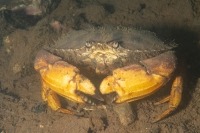
(Photo: Claire Goodwin)
Jonah Crab
Cancer borealis
Rosy to brick-red crab with a fan-shaped carapace with a rough texture. Large claws with black tips. Females are smaller than males reaching around 150 millimetres carapace width whereas males reach 220 millimetres. Both undertake about 14 moults as they grow.
Authority
Stimpson, 1859
Classification Details
Phylum: Arthropoda (arthropods); Subphylum: Crustacea (crustaceans).
Habitat
Found on the Atlantic coast of North America from Newfoundland to Florida, from the intertidal to over 800 metres. Substrates range from rocky seabeds in the Gulf of Maine to silt and clay on the continental slope.
Diet
Eat live prey, including worms, clams, mussels, and other crabs. Also scavenge on dead animals. Grab prey with their large front claws before chewing it up with their mouthparts.
Reproduction
Jonah crabs can be male or female. Males mate with females, transferring sperm using modified legs. Mating takes place after the female has moulted, and she can store sperm for an indefinite time. The female later lays her eggs. She keeps the eggs on her abdomen under her tail for five to six months. The eggs eventually hatch into plankton-feeding larvae that swim for months before they change into small crabs. Rock crabs live for around eight years.
Fun Facts
Jonah crabs can sense the temperature of the surrounding seawater and then, if it is too high or low, move to more suitable areas. Crabs that are raised in warmer water come to prefer warmer temperatures.
It can be challenging to tell Jonah crabs apart from the closely related rock crab (Cancer irroratus). The saying “smooth as a rock” is a good reminder that rock crabs have smooth carapaces, unlike the bumpy ones of the Jonah crab. Jonah crabs also have spines along their claw tips whereas the rock crab pincer is smooth.
References
Donahue MJ et al. (2009). Predation risk, prey, abundance and the vertical distribution of three brachyuran crabs on Gulf of Maine shores. Journal of Crustacean Biology 29, 523-531. Gulf of Maine Research Institute and University of Maine (2013) Jonah Crab (Cancer borealis) MSC Pre-assessment reports. Current status and information sources. Lewis L and Ayers J (2014) Temperature preference and acclimation in the Jonah Crab, Cancer borealis. Journal of Experimental Marine Biology and Ecology 455, 7-13. Pohle GW (1990) A guide to decapod crustacea from the Canadian Atlantic: Anomura and Brachyura. Canadian Technical Report of Fisheries and Aquatic Sciences 1771, 30 pp. Robichaud, DA and Frail C (2006) Development of Jonah crab, Cancer borealis, and rock crab, Cancer irroratus, fisheries in the Bay of Fundy (LFAs 35-38) and off southwest Nova Scotia (LFA 34): from exploratory to commercial status (1995-2004). Canadian Manuscript Report of Fisheries and Aquatic Science 2775: iii + 48 pp. Squires HJ (1990) Decapod crustacea of the Atlantic coast of Canada. Canadian Bulletin of Fisheries and Aquatic Sciences 221, 532 pp.

